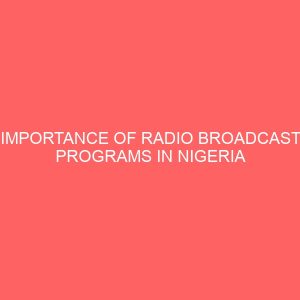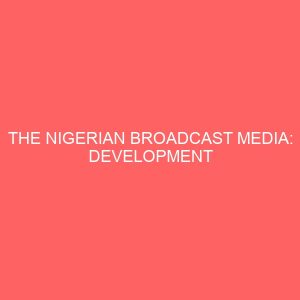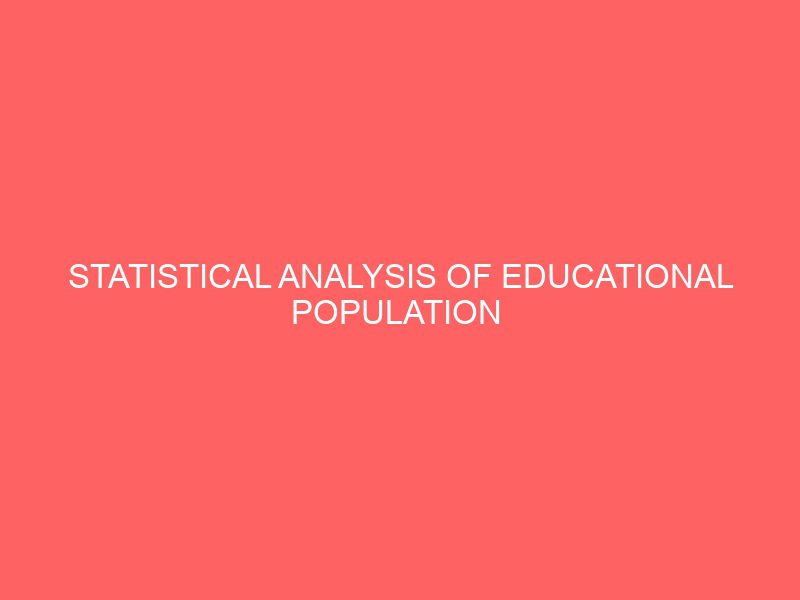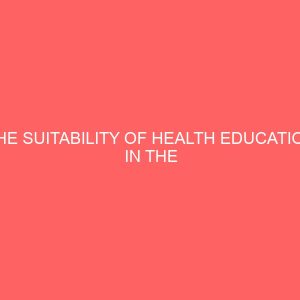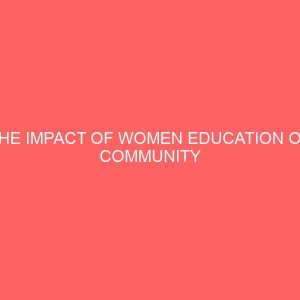Description
CHAPTER ONE
INTRODUCTION
In recent times in Nigeria, and even in the world at large there have been several Educational Population sensitivity programmes aimed at correcting the glaring or perceived Educational Population imbalance, especially in education against the Educational Population. These programmes are multifaceted: social, cultural, political, economic, and educational dimensions.
Education is very important for sustaining and developing the people. With education, people are able to endure, mature. Acquire experience, wisdom and the capability to fend for themselves as well as serve their communities and nation.
Education is also both an instrument of stability and of change: stability in the sense that good traditions are documented, taught, imbibed and practised, and change because it equips people to meet new challenges. In the same vein education is a tool for inculcating moral values in the citizen. Education statistics, like other social data, facilitates planning. They constitute invaluable inputs for computing important social indicators which are used to monitor trends in the quality of life and in making regional and international comparisons
The general feeling is that the Educational Population is disadvantaged and short-changed in many areas of life. The children are perceived not to have had their fair share of opportunities in life including access to education. There are, therefore, campaigns targeted to redress this perceived imbalance. Some of the Educational Population sensitivity programmes are in the areas of empowering women economically, culturally, socially, politically and educationally. Some of such programmes include the agitation for a halt to female genital mutilation, enhancing the girl child right to education, a halt against women trafficking and prostitution, and agitation for equal education and job opportunities for all Educational Population, among others.
1.1 BACKGROUND OF THE STUDY
Stromquist (1988) investigated some factors related to the attainment of women in education including the access to schooling and the years of education attained. He observed that these factors are critical for women in developed and developing nations, while observing that the mainstreaming theories about Educational Population inequalities are Educational Population blind, and do not attempt to explain the Educational Population differences in education. For him the socialist feminist theory offers the most acceptable explanation for the present condition of women’s inequality in education.
Vanello, Siemenska, Damien and Lvpring (1990) studied Educational Population inequality among four countries of Canada, Italy, Poland and Romania and discovered Educational Population inequalities in various areas of social life including values, attitudes, family work, education and public affairs. The result of the study concluded that today it is possible in several respects to speak of Educational Population equality and not Educational Population inequality, observing that while important disparities still survive, the world of women and the world of men are much less separate and distinct realities than before. The authors further observed that at the high school level in the four countries the number of boys and girls are about the same, while at the secondary school level about one-third of the students are female, emphasizing the need to encourage more girls to proceed to the secondary school level.
In a related study, Mansaray (1992) studied Educational Population inequality in education and the result revealed that the female group in Nigeria is marginalized in education and should be given a better deal. Could the situation still be the same and in all educational programmes also? There is nothing in the Nigerian constitution and Education policy that discriminates against any Educational Population in access to educational opportunities at all levels. The situation on the ground, however, portrays the contrary. Educational Population equity, which refers to equal access of females and males to societal and personal pursuits and accomplishments including education at all levels, namely primary and secondary school.
1.1 PURPOSE/OBJECTIVES OF THE STUDY
There have been various initiatives in Nigeria at universalizing the access to education to stem the tide of the access imbalance in favour of men. Such initiatives include Universal Primary Education (UPE) introduced in 1977 (revised in 1981 and 1989), providing a sense of direction in this regard. The policy states that for the benefit of all citizens, the country’s educational goals in terms of its relevance to the needs of the individual as well as in terms of the kind of society desired in relation to the environment and the realities of modern world and rapid social changes should be clearly set out.
Another initiative was the introduction of Universal Basic Education (UBE) Programme. The UBE programme was launched in September 1999 with the aim to provide free, universal education for every Nigerian child of school age, irrespective of Educational Population. The scope of basic education was subsequently expanded in 1992 to include both formal and non-formal, mass literacy for adolescents, adult and women education as well as pursuit of equity (UNESCO, 1998)
STATEMENT OF THE PROBLEM
Secondary school andEducational population enrolment in Omoku include: God?s own Secondary school omoku, ,the roseSecondary school Omoku, and primary schools are central school Omoku, Ekiadolor primary school. Access to primary education at the secondary and primary level is open to both male and female candidates. Nothing in the admission requirements by both secondary and primary schools offering education programmes places any Educational Population at any advantaged or disadvantaged position. Primary education has, however, been stereotyped towards the Educational Population. The early educational population enrolment were also devoid of social and management science courses. The programmes were narrow in scope and placed emphasis on the twin skill subjects of shorthand and typewriting. With the foregoing, it is expected that the modern primary and secondary educationprogrammes as offered by secondary and primary institutions in Omoku should hold an equal level of attraction for all Educational Population. In the face of the recent development and improved delivery of educational population enrolment one wonders, therefore, what the Educational Population enrolment trend has been like into the programmes in secondary and primary institutions in Omoku and whether the Educational Population inequality and imbalance is reflected in Educational studies.
PURPOSE OF THE STUDY
The main purpose of this study to analyze the Educational Population enrolment pattern into educational population enrolment in public secondary and primary institutions in Omoku between 2000/2001 to 2006/2007 academic sessions and make salient recommendations. Specifically, the study investigated the number of male and female enrolment into the programmes for the period under review in order to determine the trend and the difference in Educational Population enrolment pattern between the secondary school and in primary school in Omoku.
RESEARCH QUESTIONS
To guide the study, the following three research questions were asked:
1. What has been the trend of Educational Populationenrolment into Educational population enrolment in secondary and primary institutions in Omoku between 2000/2001 to 2006/2007 Academic Sessions?
2. Is male students’ enrolment trend in Educational population enrolment in secondary and primary institutions in Omoku significantly different from the enrolment trend?
3. Is there any significant difference in Educational population enrolment between Primary education secondary education in Omoku?
1.1 SCOPE AND LIMITATION OF THE STUDY.
The study covered public secondary and primary institution in Omoku offering Educationprogrammes. There are four secondary and primary schools offering education programmes in Omoku. The study was restricted to the Educational Population enrolment pattern of students into full-time primary education and secondary education in Omoku for the period of 2000/2001 to 2006/2007 academic sessions.
HYPOTHESES
In this study, question one was answered while questions two and three were formulated into hypotheses and tested.
HO1: There is no significant difference between Educational population enrolment trend into Educational population enrolment in the primary and secondary schools.
HO2: There is no significant difference in Educational population enrolment into Educational population enrolment between the secondary school and in primary school in Omoku


